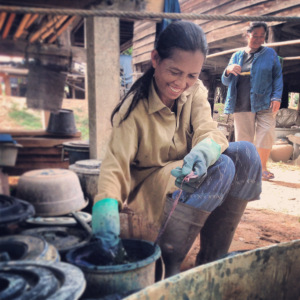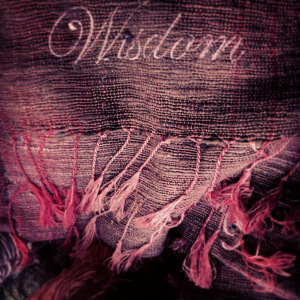Crowdfunding success - heirloom scarves and women’s empowerment
APOCCAS - heirloom scarves, handmade virtuously
Earlier this year Alexandra du Sold had an amazing success with her project to raise funds for her new season collection of scarves by ‘pre-selling’ its pieces via attractive rewards at friends & family discount prices. The campaign on IndieGoGo raised £12,354 of its £9,000 goal in October 2013.
All photographs and videos from the project are credited to Marisa Marchitelli - marisaportfolio.com
The scarves she says are “based on a unique philosophy of body, mind and soul feelgoodism and heirloom luxury that embrace concepts of pure sustainability on the one hand, and women’s empowerment on the other. These four main pillars make up the scarf itself”.
I asked her a few questions about her campaign
Q Why did you decide to crowdfund?
Answer: crowds are powerful by any standard. “Win the crowd and you will win your freedom“, wise words spoken in the Hollywood film Gladiator. This isn’t about our freedom, it’s about the livelihood and independence of its core creators – the master weavers of Ancient Siam. APOCCAS (which means Ancient Power on Cashmere, Cotton And Silk) has made it its mission to give these women a voice around the globe. Seeking endorsement via crowdfunding was a clever and cost-effective way for us to find validation by casting our net wider.
Q Who backed your project?
Answer: Crowdfunding campaigns embody an intrinsic and often dangerous myth, namely that throwing a campaign video out there with a bit of text – be that on Kickstarter or Indiegogo – will reel in the crowds by itself. Make no mistake, crowds don’t gather and lend support for nothing. Martin Luther King didn’t win them over by having a plan, he won them over by having a dream. Communicating that dream and creating a following is the difficult part. Derek Sivers in his TED talk illustrates the art of the latter hilariously. Crowdfunding is brilliant because it presents the opportunity to start with one’s nucleus (friends & family, coworkers & acquaintances) to fan out from there into second, third and random degrees of separation - all with the help of social media channels.
Content and visuals are key; if they speak to the heart of an audience that is channeled towards the campaign then an idea can spread or go viral. Prior to launching, we spoke to a number of crowdfunding campaign owners who kindly shed light on the statistics behind a successful campaign. Ordinarily, around 80% of funds raised arrive from existing first and second degree networks leaving the random ‘crowd’ factor rather peripheral. The APOCCAS campaign was no different to start with but it mushroomed into a sea of random contributors towards the tail end.
In total, APOCCAS exceeded its £9,000 goal by nearly 40%. We raised £12,354 in 27 days from
- 105 contributors, who pledged 114 times altogether
- 70 pledges or 78% of the total raised from men
- 44 pledges or 22% of total raised from women
- 64% from 1st degree contacts and the remaining
- 24% of all contributions came from random backers.
- 12% from friends of friends.
These backers were from
- over 20 different countries
- 50 contributions from the UK or 35% of total
- 17 from the USA or 9%
- 12 from Thailand or 8%
- other contributing countries were Oman, Argentina, Australia, Japan and Malaysia, just to name a few.
The two highest single contributions came from Switzerland and Monaco respectively, both from individuals in the oil and natural resources business with a great affinity to Corporate Social Responsibility (CSR).
Question: How much were the women (women’s groups) involved?
Answer: The women’s groups only played a marginal role in our crowdfunding experience as we didn’t contact them until well into the last week of our campaign. We did receive some coverage from a few of the women’s platforms who published our campaign via social media or wrote small blogs about us. Strangely, quite a few of the women’s groups insisted on advertorial, not editorial coverage – something we didn’t feel was appropriate at that stage.
Question: How much did you plan?
Answer: We started planning two to three months prior to launching our campaign when we commissioned photographer and videographer Marisa Marchitelli to help us with our photography and campaign video needs. We shot the footage at the source – in our master weaving villages across Thailand – to give our backers glimpses into the life and livelihoods of rural communities we are looking to preserve.
It was of utmost importance to us that our messages were distributed directly to each and every potential pledger – no bulk emails were sent and much follow-up was done in laborious, one-on-one exchanges. This may be so last century to some but if you feel your campaign is important, please don’t make your backers feel like a ticked box.
And last but not least – never underestimate the element of surprise; there are things you cannot plan for so it’s crucial to stay on your toes and remain nimble. Select your team very carefully and communicate continuously throughout. Coverage of different timezones is definitely a plus and aids momentum.
Question: Why did you choose IndieGoGo?
Answer: Truth be told, our preferred choice of platform was Kickstarter but our application was rejected; we appealed and it was denied again. Kickstarter has a pre-approval process based on certain (rather obscure) guidelines which we allegedly did not meet. Their exact wording was: “While creative endeavors can have a charitable bend and still be acceptable, when the core of a project is inseparable from the cause surrounding it, it falls outside of our scope.” We feel we were discriminated against because we chose (does not equal inseparable) to use “women’s empowerment” as a marketing message while Kickstarter clearly mis-viewed this as a cause inextricably tied to the creative project.
Indiegogo accepts all campaigns – perhaps not ideal either but certainly less restrictive. Indiegogo’s huge drawback is its payment integration process. The California-based platform imposes greater fraud security measures on US pledgers who wish to contribute to international campaigns (ours is a UK-registered company). This created real problems for us with our willing, yet blocked, US-based pledgers. We were offered a campaign end date extension in case we didn’t reach our goal in time. Two days before the end of the campaign (we had already surpassed our goal), the newsletter department of Indiegogo announced that our rewards had made it to their ‘recommended’ list, which was emailed out to the platform’s loyal (and majority US) customer base.
While grateful to end on a high – our single highest aggregated contribution day was in fact our last day, there is no doubt in my mind that the random pledgers were just getting going – we had email requests for rewards from some of them for a whole week after the campaign had already closed.
Question: Can you give two tips for other crowdfunders
Answer:
1. Prepare for an incredibly stressful time as long as the campaign runs – and we mean, double whatever you think you’d normally be able to bear. The term crowdfunding is misleading – it really is your own effort with your own networks. So be reasonable with your crowdfunding goal.
2. Don’t underestimate the power of small pledges by many people – and please encourage those! The algorithms of any crowdfunding platform favour you for driving traffic to their site, not for how much you raise from individual pledges.
“All or nothing” campaigns are highly overrated - particularly in light of the added pressure they create – although statistics strongly suggest that they may well generate more momentum; we went with “keep what you earn” on Indiegogo and it never became an issue.
Other than that – go forth and win that crowd over so you will win your freedom, at least for a little while anyway! :–)
Find out more about APOCCAS and Alexandra’s campaign
http://www.indiegogo.com/projects/apoccas-heirloom-scarves-handmade-virtuously


This was an excellent interview. Thanks so much for sharing. Very insightful. I will apply her suggestions for my kickstarter.